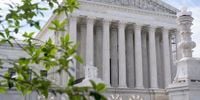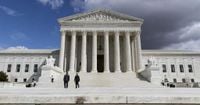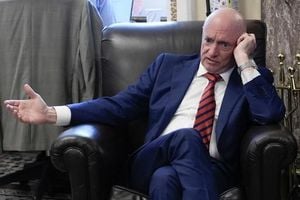President Donald Trump is once again at the center of a high-stakes legal and economic battle, as his administration urgently appeals to the U.S. Supreme Court to uphold a sweeping set of tariffs imposed on imports from major trading partners. With the fate of these tariffs—and potentially the boundaries of presidential power—hanging in the balance, the administration is warning of dire consequences if the justices do not act quickly.
On September 4, 2025, Trump and his top officials, including Treasury Secretary Scott Bessent and Commerce Secretary Howard Lutnick, pressed the Supreme Court for an expedited review of the tariffs, which were enacted earlier this year under the International Emergency Economic Powers Act (IEEPA). These so-called “Liberation Day” tariffs targeted imports from China, Mexico, and Canada, and have become a flashpoint in both domestic politics and international trade negotiations.
The urgency is palpable. The administration’s filings, as reported by AP, Fortune, and Law&Crime, use language rarely seen in Supreme Court cases, warning that striking down the tariffs would place the U.S. “on the brink of economic catastrophe.” Trump himself has been even more blunt, telling reporters at the White House, “If you took away tariffs, we could end up becoming a third-world country.”
At the heart of the dispute is whether the president has the authority to unilaterally impose tariffs under IEEPA, a law that gives the executive branch broad powers during national emergencies. In August, the U.S. Court of Appeals for the Federal Circuit delivered a 7–4 ruling that these tariffs were unconstitutional, finding that the IEEPA “does not authorize the tariffs imposed by President Trump pursuant to the national emergencies declared.” The court left the tariffs in place temporarily, but its decision cast a shadow over ongoing trade talks and existing deals.
Solicitor General D. John Sauer, representing the administration, urged the Supreme Court to decide by September 10 whether to take up the case, with oral arguments scheduled for the first week of November—an unusually rapid timeline for the high court. “The President and his Cabinet officials have determined that the tariffs are promoting peace and unprecedented economic prosperity, and that the denial of tariff authority would expose our nation to trade retaliation without effective defenses and thrust America back to the brink of economic catastrophe,” Sauer wrote in his filing.
Backing up these warnings, Secretary Bessent declared under penalty of perjury that the Federal Circuit’s decision had “gravely imperiled ongoing negotiations” with other nations and existing agreements. Drawing a direct line to past crises, Bessent argued, “The United States had last experienced an economic ‘tipping point’ back in 2007, when almost no one foresaw or took any action to prevent the 2008 mortgage crisis. Emergency action is warranted to prevent a financial shock.”
The legal challenge to the tariffs began in mid-April, when V.O.S. Selections, an alcohol importer, along with a coalition of twelve Democratic-led states, filed lawsuits alleging that the tariffs were causing chaos in pricing, shipping, inventory, and cash flow. Their suits were later consolidated. At oral argument, appellate judges pointed out that the IEEPA statute does not mention “tariffs” or “duties” anywhere, raising questions about the law’s intended scope.
In the meantime, the economic impact of the tariffs has been dramatic—and divisive. According to Fortune, Morgan Stanley predicts the tariffs could generate as much as $2.7 trillion in revenue over the next decade, with between $750 billion and $1 trillion already collected by June 2026 if the Supreme Court delays its decision. By late August, tariff revenue had already reached $159 billion, more than double the previous year’s total, according to AP.
But the costs have not been evenly distributed. Experts cited by Fortune and the Congressional Budget Office note that tariffs have raised average household expenses by over $1,300 annually, disproportionately impacting low-income Americans who spend a larger share of their income on imported goods. Manufacturing sectors like steel have seen some benefits from the protection, but industries reliant on imported components—such as automotive and electronics—have faced higher input costs, squeezing both businesses and consumers.
Small businesses, in particular, have felt the pinch. Jeffrey Schwab, senior counsel at the Liberty Justice Center, told AP, “These unlawful tariffs are inflicting serious harm on small businesses and jeopardizing their survival. We hope for a prompt resolution of this case for our clients.”
While the administration frames the tariffs as essential for economic security and geopolitical leverage, critics argue that Trump’s warnings of economic disaster are overblown. Some economists predict that removing the tariffs would lead to a period of painful adjustment and market volatility, but not outright catastrophe. The Congressional Budget Office’s June analysis found that the tariffs would slow economic growth and increase inflation by 0.4% annually in 2025 and 2026, reducing the purchasing power of U.S. consumers and businesses.
The Supreme Court case also raises profound constitutional questions about the balance of power between Congress and the president. The Constitution gives Congress the authority to impose taxes and tariffs, but over the years, lawmakers have ceded broad discretion to the executive branch. Most judges on the Federal Circuit concluded that IEEPA does not allow the president to usurp Congress’s tariff powers, while dissenting judges argued that the law gives the president wide latitude during emergencies.
Notably, the current Supreme Court includes three justices appointed by Trump, and the court has generally been reluctant to rein in presidential authority. Whether the justices will uphold Trump’s use of IEEPA or reaffirm congressional control over tariffs could set a precedent with lasting implications for U.S. trade policy and the separation of powers.
If the Supreme Court ultimately rules against the administration, the consequences could ripple throughout the economy. The government may be forced to refund as much as $150 billion to businesses, and companies would need to rapidly adjust their supply chains. The White House has warned that previously agreed investments could be unwound, further destabilizing the economy.
For Trump, the tariffs are more than just an economic tool—they are a central pillar of his policy platform, tied to promises of American revival and strength on the world stage. As the Supreme Court prepares to weigh in, the outcome will not only shape the nation’s economic future but also clarify the limits of presidential power at a critical juncture in American history.
The stakes, as both sides agree, could not be higher. The coming months will reveal whether the Supreme Court is willing to uphold Trump’s far-reaching use of emergency powers, or whether it will reaffirm Congress’s constitutional role in setting the rules of trade.






